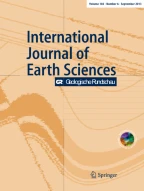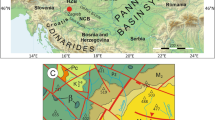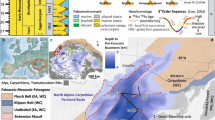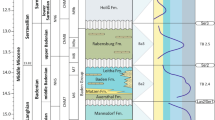Abstract
A quantitative paleobathymetric study of Badenian foraminifera was carried out from Tekeres-1 and Tengelic-2 boreholes, north of the Mecsek Mts., SW Hungary. Paleobathymetric data, based on plankton/benthos ratio provided input for the analysis of the subsidence history. The biostratigraphic framework is mainly provided by calcareous nannoplankton (zones NN5–NN7). Changes in sedimentation rates are also considered, partly calculated from number of benthos per unit sediment, and partly estimated from the changes of lithofacies. Relative sea-level changes are calculated from changes of paleowater depth and coeval sedimentary thickness. The result is examined as the sum of accommodation space created by subsidence and eustasy. In that period of time eustatic changes were about an order of magnitude smaller than changes created by movements of the basin floor. According to our model in early Badenian (up to the half of NN5 nannozone) a very rapid transtension-related subsidence of about 500 m occurred. This was interrupted by a short period of uplift of minor magnitude at about the first third of NN5 zone; thereafter, subsidence continued and the basin floor reached its deepest position. Still within the NN5 nannozone (Early Badenian) a significant uplift occurred, terminating the life of the deep basin. The Late Badenian (NN6) is characterized by a relatively small rate of subsidence and presumably quiet tectonism. During this period bathymetric changes are thought to be controlled primarily by eustatic changes. The first uplift – only interrupting subsidence – is regarded as the result of the change of the local stress field because of convergence along the curvature of strike slip faults. The second uplift, which stopped the subsidence of the basin floor is thought to be of a regional character and is attributed to the compression generated between Tisza and Alcapa tectonic units.
Article PDF
Similar content being viewed by others
Avoid common mistakes on your manuscript.
Author information
Authors and Affiliations
Corresponding author
Additional information
Electronic Publication
Rights and permissions
About this article
Cite this article
Báldi, K., Benkovics, L. & Sztanó, O. Badenian (Middle Miocene) basin development in SW Hungary: subsidence history based on quantitative paleobathymetry of foraminifera. Int J Earth Sci (Geol Rundsch) 91, 490–504 (2002). https://doi.org/10.1007/s005310100226
Received:
Accepted:
Published:
Issue date:
DOI: https://doi.org/10.1007/s005310100226




